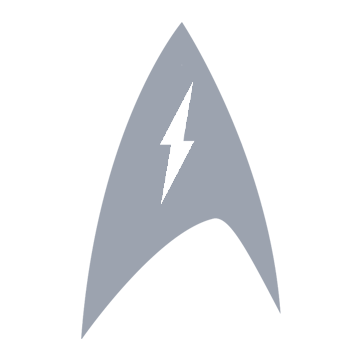Ship’s Log, USS Arcturus. Captain Akintoye Okusanya recording.
We have altered course to Sentinel Major by order of Fourth Fleet Command. Our mission is to upgrade the long-range sensor array located in this system to increase its utility in predicting the path of the ongoing Century Storm. The specifications Starfleet provided have been relatively simple to produce, so I anticipate concluding this mission swiftly.
End Log
While she would never admit it, Captain Lancaster’s supposition had been correct: Akintoye Okusanya preferred life in the engine room to the bridge. Each time she had ambitions of command, she was swiftly disabused of them by the realities that came with the center seat. Why Lancaster had deigned to take the next senior-most officer along with him on his excursion was beyond her, it had left it to her and Lieutenant Commander Odea to fill in the gaps of a very strained duty roster. After a year of having four captains and a half-dozen commanders on the senior staff, the Arcturus had finally encountered a problem that it had never faced before: a lack of experienced bridge officers.
Typically, the department heads could be supplemented with commanders from other departments, especially in engineering and operations, but those officers were needed to get ready for their mission. Dr. Sheppard acting as the senior medical officer, that was one fewer name to toss onto the roster. Without pulling double or triple shifts, they’d need more bodies.
“Ma’am, if I may?” Ensign Kaplan asked, seated in front of the desk where he was taking notes on his WRIST interface.
The engineer nodded. Okusanya had left her own yeoman at Commander Slater’s disposal, so she’d inherited Lancaster’s. They hadn’t interacted much in the past, but she had quickly come to find out that he was much savvier than his blond-haired, blue-eyed appearance had led her to believe.
“There are several lieutenant commanders in the science and medical divisions who have passed the bridge officer’s exam but who have not yet been promoted to commander. If they’re added to the roster, that should balance the rotation and allow Lieutenant Commander Bowens and Lieutenants Windsor and Tellora to remain on call,” he suggested.
Okusanya glanced at Odea, who nodded; she wasn’t aware that those officers had hidden talents. “An apposite suggestion, Mr. Kaplan. I see we finally see who the power behind the throne is,” she said, chuckling at her own joke. “Please make the arrangements with the first officer.”
“Of course, Captain,” the young man replied, tapping away at his screen. The roster began to populate with enough officers to keep a senior officer on the bridge at all times, without taxing their three officers of the watch to the breaking point, considering Bowens and Tellora also had duties related to the hazard teams, which they would likely need when they got to Sentinel Major.
“Why haven’t they been promoted yet, out of curiosity?” the captain asked.
Kaplan’s face betrayed a moment of confusion, which he contorted into a smile. “It varies from individual to individual, but generally it’s because of an ongoing credentialing–,” he started, but Okusanya held up her hand.
“It’s complicated. Understood. Thank you, Ensign,” she said.
“Bridge to Captain Okusanya. We are arriving at Sentinel Major,” Lieutenant Commander Marshall reported over the comm.
“Understood. Take us into standard orbit,” Okusanya replied, tapping her badge to close the call.
Kaplan and Odea looked at each other and then at Okusanya. The Betazoid cleared her throat.
“Regulations require the captain’s presence on the bridge for all orbital insertion maneuvers, sir,” she reminded her.
“Right. Because the ship’s senior helmsman can’t be trusted to do that on his own?” Okusanya quipped. “Let’s go see if this gas giant’s all it’s cracked up to be, then,” she said, leaving the two officers to follow in her wake as she passed through the foyer and onto the bridge.
“Captain on the bridge!” Lieutenant Windsor announced from the first officer’s station next to Marshall in the center seat as the bosun’s whistle sounded.
“Don’t do that,” Okusanya replied, shaking her head.
“Aye, Captain,” Windsor replied, giving his seat to Odea as Marshall took the helm from Ensign Solomon. The tall lieutenant took the seat to the other side, sharing a look with Kaplan that did not escape Okusanya’s notice.
“You are more than free to resume your formalities when Captain Lancaster returns,” Okusanya said, crossing her legs as she sat down on the command throne. “What’s our status?”
“We’re approaching Sentinel Major III, preparing to enter orbit,” Marshall reported from the helm. “I have the Sentinel Major Outpost on sensors.”
“Well, at least it’s where it’s supposed to be, then,” Okusanya noted. “Put is in synchronous orbit between the primary orbital control node and their aerostat facility.”
“Aye,” Marshall replied.
The Arcturus dwarfed the orbital facility that made up half of the Sentinel Major Outpost, officially named “Deep Space Telescope Array Mu-Zero at Sentinel Major.” That facility controlled a network of satellites forming a web around the gas giant Sentinel Major III, generally known as Sentinel Major, rather than the system’s primary, a red dwarf. This was due to a case of mistaken identity in 21st-century astronomy, which had erroneously assumed that the planet was actually a brown dwarf and not simply an enormous type-II gas giant. The satellites used multiple simultaneous data points to measure subspace phenomena with great accuracy.
Beneath the orbital facility was an aerostat installation, which floated in an oxygen-rich inhabitable layer of the planet’s atmosphere. Sentinel Major III had a much less intense magnetosphere than other large gas giants such as Jupiter, making it suitable for colonization. Even still, there were only two hundred scientists at the facility—primarily civilians—because there were so many more attractive options for settlement in the Federation. Apart from the scientists who studied data from the long-range sensor array, there was also a sizable contingent of astrobiologists studying the ecosystem of aerostatic flora, flying fauna, and other unique life forms that had managed to evolve in the planet’s atmosphere.
“Now entering orbit, Captain,” Marshall reported.
“We are being hailed,” Lieutenant Galan reported.
“Open a channel,” Okusanya replied, standing up and moving forward to stand on the Federation seal in the center of the bridge as the viewscreen connected with the outpost’s operations system.
“Arcturus, this is Sentinel Major. We have you on our sensors. I’m Lieutenant Maximillian Vahlen, commanding officer of this facility,” a young man reported. He was wearing a blue uniform and looked awfully familiar.
“I’d hope that you could detect our approach, given that this is a deep-space telescope array,” the engineer noted.
Vahlen chuckled nervously. “Right you are, ma’am. We just received a copy of your orders from Starfleet Command. My facility is at your disposal,” he noted.
“I’ll be sending down an engineering team to ensure that our specifications match the current state of your equipment. I estimate that we will be able to complete the project within thirty-six hours,” she replied.
The lieutenant nodded. “The scientists here have been asking for these upgrades since before I took command. We’re happy to help however we can,” he said.
“Excellent, Lieutenant,” Okusanya replied, starting to turn around to return to her seat, but she stopped herself. “Do you have an older brother? Just out of curiosity.”
“Yes, ma’am. I’m surprised Theo didn’t mention I was stationed here. Will he be beaming down as well?” the younger Vahlen brother replied, with a tone of hope that stabbed Okusanya right in the heart.
“He’s no longer on the Arcturus. He took an assignment on Earth,” she replied. “There’s some irony for you.”
Vahlen nodded. “Yes, ma’am. I’m sending transporter coordinates now. Sentinel Major out,” he said, cutting the channel in a mild breach of protocol, being the junior commander in that exchange.
“What are the odds?” Okusanya asked, mostly to herself. “Not telling his brother that he’s now a tenured professor at Starfleet Academy definitely tracks with Commander Vahlen’s character.”
Lieutenant Windsor nodded. “He did always strike me as a little, uh, evil, ma’am.”
“Well, let’s hope his brother fell a little further from the tree, then. I don’t want this to be one of those holonovels where we’ve stumbled upon a jumped-up colonial official who’s let power go to his head and is running some sort of cult beyond the notice of Starfleet,” the engineer replied, sitting back down.
“I didn’t know we even had holonovels like that,” Windsor replied, his eyes getting wide.
“They probably don’t on Penthara IV,” Okusanya muttered. “Commander, please accompany the engineering team to the station.”
“I’ll be on the lookout for any cults or power trips, ma’am,” Odea quipped. “Odea to Van Dorland. Meet me with your team in transporter room four. Galan, you’re with me.”
Once Odea had left the bridge with the communications officer in tow, the bridge was left quiet while they waited for the team to assemble and beam down. It was interminable.
Okusanya turned to Windsor. “What do you do on the holodeck if not parse out complicated murder mysteries in realistic but fantastical scenarios?”
“I can never figure out those mysteries. I like the beach,” Windsor replied brightly. “Arturo—Lieutenant Hidalgo—”
“Yes, I know who Ship is,” Okusanya replied, arching an eyebrow; while she didn’t often wade into the fray with her junior officers, she did at least know that one’s very appropriate nickname.
“Er. Of course. Well, anyway, he likes the historical ones, and I pretty much let him pick whatever he wants,” the lieutenant continued.
“That’s very sensible. Always give engineers what they ask for,” Okusanya replied, drumming her fingers on the armrest of the chair. “What’s taking them so long?”
“It’s only been thirty seconds, ma’am,” Windsor reminded her.
“What do bridge officers do all day?!” she wondered aloud. Windsor opened his mouth to respond, but she held up her hand. “Never mind. I don’t need the details of all the reports you probably read, sign, write, and archive every shift.”
“Once they report in, you can give Lieutenant Commander Marshall the bridge again,” Windsor noted in a lower voice. “I usually use the time to do seated core exercises, though.”
“Of course you do, Mr. Windsor,” the engineer replied, watching as the lieutenant sat up to his full height and demonstrated an exercise that was essentially just flexing in place. It was everything she’d ever derisively thought about command-line officers in one instance. “Of course you do.”

 Bravo Fleet
Bravo Fleet








